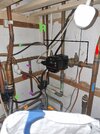This might be better , blue is from boiler, red is vent, green is feed from tank, purple is bypass and orange is return to boilerView attachment 292854
I would reposition the cold feed to between vent and pump. Personally I'm not keen on the vent going straight up from a tee like that, as it's more likely to cause flow out of the vent (the opposite problem to what you have now). I prefer the vent to come off the top of a horizontal run. Might be a bit tight, but hopefully it will go in. The cold feed should go up and under into the pipe, to reduce convection warming the header tank, and encouraging algae growth.
Last edited:


